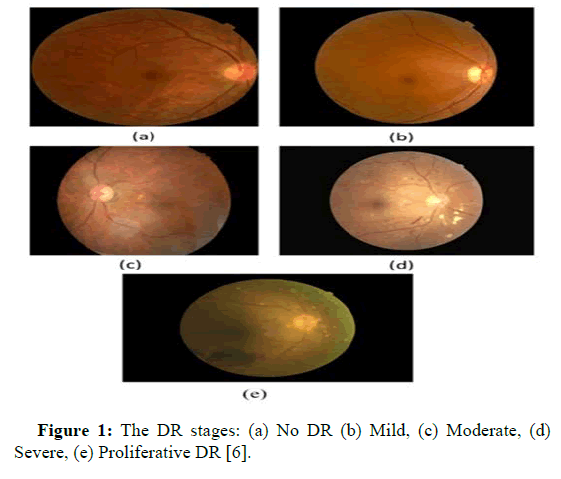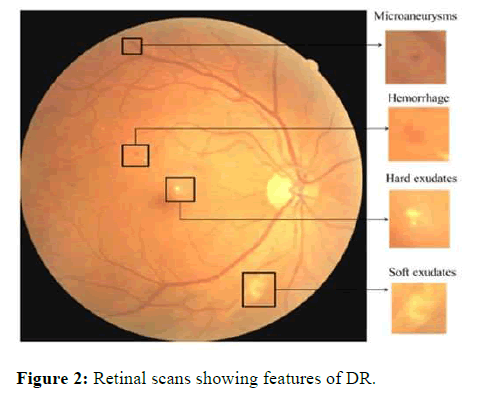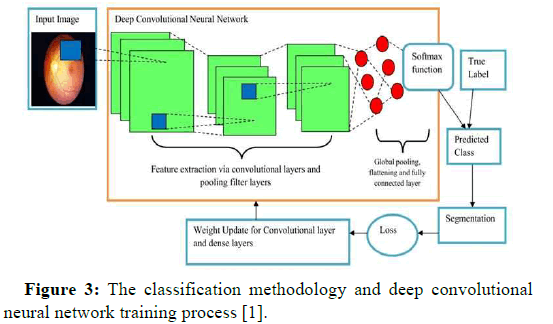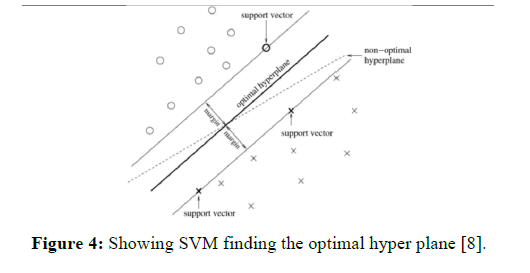Review Article, Int J Ophthalmic Pathol Vol: 12 Issue: 3
Diabetic Retinopathy Detection using Artificial Intelligence and Machine Learning Approach-A Research
Kumar Abhishek, Mansi Bhandari, Richa Gupta*, Jawed Ahmed and Sufian Badar
1Department of Computer Science and Engineering, Jamia Hamdard University, New Delhi, India
*Corresponding Author: Richa Gupta,
Department of Computer Science
and Engineering, Jamia Hamdard University, New Delhi, India
E-mail: richagupta@jamiahamdard.ac.in
Received date: 29 April, 2023, Manuscript No. IOPJ-23-97377;
Editor assigned date: 03 May, 2023, Pre QC No. IOPJ-23-97377 (PQ);
Reviewed date: 17 May, 2023, QC No. IOPJ-23-97377;
Revised date: 24 May, 2023, Manuscript No. IOPJ-23-97377 (R);
Published date: 31 May, 2023, DOI: 10.4172/2324-8599.12.3.020
Citation: Abhishek K, Bhandari M, Gupta R, Ahmed J, Badar S (2023) An Analysis of Artificial Intelligence Approach for Detecting Diabetic Retinopathy. Int J Ophthalmic Pathol 12:3.
Abstract
In the modern world, diabetes affects people of almost all ages frequently. A rise in blood sugar levels above the normal limit is a symptom of diabetes. Long-term diabetes damages the tiny blood vessels in the light-sensitive tissue at the back of the retina through micro aneurysms, hemorrhages and neovascularization, leading to diabetic retinopathy. The initial diagnosis of diabetic retinopathy is challenging because it necessitates superior retinal scans and a qualified ophthalmologist for its study, especially in remote areas where people lack access to such qualified ophthalmologists and cutting-edge technology. Determining the severity of Diabetic Retinopathy (DR) using deep learning algorithms and a variety of classifiers is thus a novel strategy used in this research.
Keywords: Diabetic retinopathy; Hemorrhages; Neovascularization; Micro aneurysms
Introduction
Diabetic Retinopathy (DR) is an eye disease brought on by diabetes issues that damage the blood vessels in the light-sensitive tissue at the rear of the eye. Early in the progression of this condition, exudates, vascular hyper permeability signals, micro aneurysms, a dotted them in the eye fundus and clotted capillaries are all affected by retinal several diseases in the microvasculature. Retinal degeneration in its early stages cannot reverse diabetic retinopathy's damage; it can only delay the disease's progression. Individuals who have been affected by these early lesions are anticipating a novel possibility: identification by careful examination (mainly micro aneurysms and tiny blood cells) fluorescence and drifting has improved with retinopathy treatment and sudden vision loss and haziness are common in 2.6% of the world's sources of blindness are attributed to DR. Long-term diabetes; high hemoglobin A1C levels and high blood pressure readings are the main risk factors for getting DR [1,2].
According to the International Diabetes Federation's estimate, there will be more than 600 million patients who will be suffering from DR by 2050. DR is thought to have been the first disease to endanger human eye health. Thus, for those who have DR, early diagnosis and therapy are essential to avoiding blindness. There is general agreement that early detection and treatment can lower DR patients' chance of blindness to 5% [3].
Between December 20, 2018 and March 20, 2020, a study for diabetic retinopathy was conducted on people 40 years of age or higher in eleven Indian states and one union territory using a complex cluster sampling strategy [4].
A brief description of the stages of Diabetic Retinopathy (DR) is as follows:
Grade 1
Mild Non-Proliferative Diabetic Retinopathy (Mild NPDR) has at least one micro aneurysm, whether or not it is accompanied by hard exudates, cotton wool patches, or hemorrhages.
Grade 2
Moderate Non-Proliferative Diabetic Retinopathy (Moderate NPDR) is characterized by the appearance of more retinal hemorrhages and micro aneurysms. There may also be cotton wool spots and a small quantity of venous beading
Severe Non-Proliferative Diabetic Retinopathy (Severe NPDR), at this point, there are more micro aneurysms, retinal hemorrhages and hard exudates.
Grade 3
Proliferative Diabetic Retinopathy (PDR) is the advanced stage; the retina's cues for hydration allow for the development of new blood vessels. These brand-new blood capillaries are delicate and flimsy. If they leak blood, it could cause a serious loss of vision or even blindness (Figure 1) [5].
Figure 1: The DR stages: (a) No DR (b) Mild, (c) Moderate, (d) Severe, (e) Proliferative DR [6].
In the case of mild Non-Proliferative Diabetic Retinopathy (NPDR), the micro-aneurysms are observed. During the moderate NPDR, micro aneurysms, hemorrhages, and hard and soft exudates are seen. In severe NPDR, blockage of certain blood vessels in the retinas and development of weak new blood vessels..
The PDR-damaged retina has the effect of forming new blood vessels showing neovascularization of an abnormal nature and is developed at the back of the eye; as a result, the vision is blurry, it can burst or bleed (Figure 2) [7].
This paper reviews using various classifiers that can detect hemorrhages, micro aneurysms and macula in the early detection of DR. Automated or semi-automated Semantic Segmentation (SEG) is a technique for locating boundaries in 2D or 3D images. A technique for splitting a picture into pertinent parts with standardized attributes is called image segmentation. To address this unpredictability, several attempts have been undertaken to develop algorithms that automatically identify and monitor micro aneurysms in the ocular fundus. In terms of picture analysis and interpretation, Deep Convolutional Neural Networks (DCNNs), a subtype of deep learning, offer outstanding data that can be applied to a variety of industries, including medical imaging [1].
Classifiers
An approach to machine learning where a data input is given a class label.
Decision tree: Although it can be used to solve classification and regression problems, a decision tree is a supervised learning technique typically favored for classification problems. It is a tree-structured classifier, where internal nodes stand in for a dataset's features, branches for the decision-making process and each leaf node for the classification result. The features in the given dataset are used to inform the judgments or tests. It is a visual representation of every option for solving a dilemma or making a choice under specific circumstances. The Classification and the Regression Tree (CART) algorithm are used to construct a tree.
Artificial neural networks: Artificial Neural Network (ANN) is a type of machine learning model that is inspired by the structure and functioning of the human brain. It is a type of artificial intelligence model consisting of interconnected nodes (neurons) that process and transmit information. Each neuron receives input from other neurons, processes that information and then generates output that can be transferred to other neurons. ANNs can be trained to perform tasks such as pattern recognition and classification by adjusting the weights of the connections between neurons. This enables the network to learn from experience and improve its performance over time.
Typically, an artificial neural network has three layers:
The layer of input: As the name implies, it accepts inputs from the programmer in a variety of various formats.
Uncovered layer: The input and output layers are separated by the concealed layer. To uncover hidden features and patterns, it runs all the calculations
Result layer: The hidden layer is used to transform the input into a variety of outputs, which are then communicated through this layer. The artificial neural network receives information and calculates the biased weighted sum of the inputs. A transfer function is used to visualize this computation (Figure 3).
Figure 3: The classification methodology and deep convolutional neural network training process [1].
Support Vector Machine (SVM): Utilized to solve classification and regression issues. However, it is mainly employed in machine learning to solve categorization issues. The SVM algorithm's objective is to establish the best line or decision boundary that can divide ndimensional space into classes, allowing us to quickly classify fresh data points in the future. A hyper plane is the name of this border of best judgment.
The extreme points and vectors, that aid in the creation of the hyper plane is selected by SVM.
The algorithm is referred regarded as a "Support Vector Machine (SVM)", because of these extreme cases, which are known as support vectors. Take a look at the diagram below, where a decision boundary or hyper plane is used to categorize two distinct categories:
The SVM algorithm can be applied to text classification, face identification, picture classification, and more (Figure 4).
Figure 4: Showing SVM finding the optimal hyper plane [8].
SVM comes in two varieties:
Linear SVM: Linear SVM is used for data that can be divided into two groups using a single straight line. This type of data is called linearly separable data, and the classifier used to divide it into those two classes is known as a Linear SVM classifier.
Non-linear SVM: In other words, if a dataset cannot be classified using a straight line, it is referred to as non-linear data and the classifier employed is referred to as a non-linear SVM classifier. Nonlinear SVM is used for non-linearly separated data.
Literature Review
A 2-stage training strategy is used by Chen et al. to develop a universal deep learning model for DR classification that addresses the over fitting issue [9]. In addition, they offer a straightforward technique for resolving the imbalance in DR databases. Erciyas et al. create a deep learning-based system that automatically and independently detects lesions associated with diabetic retinopathy and classifies such lesions [10]. To identify diabetic retinopathy, Vives et al. describe a bio-inspired strategy for synaptic metaplasticity in convolutional neural networks [11]. By analyzing retinal abnormalities such as hard exudates, hemorrhages, micro aneurysms and soft exudates, Jadhav et al. construct an optimal feature selection-based diabetic retinopathy detection approach that can generate automated DR detection [12]. Canayaz et al. suggest a strategy that combines feature selection with fundus image wrapper approaches [13]. EDenseNet, a hybrid deep learning technique, is introduced by Abdelmaksoud et al. They merge the EyeNet and DenseNet models via transfer learning [14].
Data labels are frequently the most expensive and challenging to gather in deep learning research. Medical photos specifically display this issue. Hence, it has become a popular topic to figure out how to effectively use current tags to forecast unknown data. One of the most well-liked areas of research is domain adaptation [15]. The vast range of data that Graph Adversarial Transfer Learning (GATL) is compatible which allows it to more effectively utilize, what data is already available while yet maintaining a high level of classification accuracy for DR. To extract the pixel features and prospective features from fundus images, GATL combines the strengths of neural graph networks and convolutional neural networks. Alignment within and between domains is the objective, guided by adversarial training. Several findings on two open datasets demonstrate that our GATL method outperforms some industry-standard DR classification techniques [16]. Using a mixture ensemble classifier built on the Gaussian Mixture Model (GMM) and Support Vector Machine (SVM), Akram et al. identified lesions in the retina [17]. To distinguish lesions from non-lesions in the provided retinal images, several classification approaches including k-Nearest Neighbors (k- NN), AdaBoost, SVM, and GMM were used. Their performances were assessed [18]. A CNN that can identify hemorrhages, microaneurysms and exudates as well as categorize retinal pictures in the five stages of the DR was proposed by Pratt et al. The Kaggle EyePACS data set was used to train the CNN. They offered a solution and fixed the over fitting and skewed dataset issues. They expanded the amount of training data by using data augmentation. Ten convolutional layers and three fully connected layers make up their CNN model. The proposed CNN has an accuracy of 75%, a sensitivity of 30% and a specificity of 95% [19]. By García et al. a DR-level classification model with CNN was created. Using the EyePACS dataset, their model achieves 93.65% specificity and 83.68% accuracy [20].
Using the Kaggle dataset with a well-known CNN called ResNet-34, Esfahan et al. were able to classify DR with an accuracy of 85%. They employed a variety of picture preparation techniques to improve the photo’s quality. The picture pre-processing methods used were weighted addition, Gaussian filter and image normalization [21]. Lam et al. used Convolutional Neural Networks (CNNs) on colored fundus images to identify the DR stage.
For 2, 3 and 4 class classification models, their network obtained a sensitivity of 95% and accuracy of 74.5%, 68.8% and 57.2%, respectively [22]. Harangi et al. integrated the current, pre-trained AlexNet with custom attributes to find all five DR levels. The CNN was tested using the Indian Diabetic Retinopathy image Dataset (IDRiD) after being trained on the Kaggle dataset. The accuracy of this study was 90.07% [23]. A deep multitasking learning (DL) model for DR detection was put forth by Mjr et al. They created a multitask model that combines a regression and classification approach. The models were trained independently and had unique loss functions. The multilayer perceptron network classifies the data set photos for diabetic retinopathy using attributes from the previous models as input. Using the EyePACS dataset, they achieved an accuracy of 82%, while on the Asia Pacific Tele-Ophthalmology Society (APTOS) dataset; they attained an accuracy of 86% [24].
Although DR cannot be cured, it is crucial to identify it early to limit future harm. For instance, no proliferative DR stages nearly always contain early signs of DR, and being able to identify and categorize those stages using the right evaluation technique may mean being able to preserve one's vision. We provide a thorough analysis of classifiers for identifying diabetic retinopathy in this research. We acknowledge that improved detection will result from the continued development of computational neural networks. Findings from several investigations indicate a promising overall classification performance with an accuracy average of roughly 91%.
Conclusions
These DL-based strategies could be incorporated into screening systems that are currently being developed to improve and categorize the DR stage using lesion detection methods across various fundus images. Further research will improve our suggested strategy in the ways that follow:
1. To increase further the classification accuracy, a more effective method of combining shallow CNNs will be investigated.
2. To enhance the performance of the integrated shallow CNN model, picture samples will be transformed and the dataset will be sampled repeatedly.
References
- Qiao L, Zhu Y, Zhou H (2020) Diabetic retinopathy detection using prognosis of microaneurysm and early diagnosis system for non-proliferative diabetic retinopathy based on deep learning algorithms. IEEE 8:104292-104302.
- Atwany MZ, Sahyoun AH, Yaqub M (2022) Deep Learning Techniques for Diabetic Retinopathy Classification: A Survey. IEEE 10:28642-28655.
- Chen W, Yang B, Li J, Wang J (2020) An approach to detecting diabetic retinopathy based on integrated shallow convolutional neural networks. IEEE 8:178552-178562.
- Raman R, Vasconcelos JC, Rajalakshmi R, Prevost AT, Ramasamy K, et al. (2022) Prevalence of diabetic retinopathy in india stratified by known and undiagnosed diabetes, urban–rural locations, and socioeconomic indices: Results from the smart india population-based cross-sectional screening study. Lancet Glob Health 10:e1764-e1773.
- Acharya UR, Ng EY, Tan JH, Sree SV, Ng KH (2012) An Integrated Index for the Identification of Diabetic Retinopathy Stages Using Texture Parameters. J Med Syst 36:2011-2020.
- Ramasamy LK, Padinjappurathu SG, Kadry S, Damaševičius R (2021) Detection of diabetic retinopathy using a fusion of textural and ridgelet features of retinal images and sequential minimal optimization classifier. PeerJ Comput Sci 7:e456.
- Alyoubi WL, Abulkhair MF, Shalash WM (2021) Diabetic Retinopathy Fundus Image Classification and Lesions Localization System Using Deep Learning. Sensors (Basel) 21:3704.
- Gupta R, Alam MA, Agarwal P (2021) Whale optimization algorithm fused with SVM to detect stress in EEG signals. Intell Decis Technol 15:87-97.
- Chen PN, Lee CC, Liang CM, Pao SI, Huang KH, et al. (2021) General deep learning model for detecting diabetic retinopathy. BMC Bioinformatics 22:1-15.
- Erciyas A, Barışçı N (2021) An effective method for detecting and classifying diabetic retinopathy lesions based on deep learning. Comput Math Methods Med 2021:1-13.
- Boix VV, Fernández DR (2021) Diabetic retinopathy detection through convolutional neural networks with synaptic metaplasticity. Comput Math Methods 206:106094.
- Jadhav AS, Patil PB, Biradar S (2020) Optimal feature selection-based diabetic retinopathy detection using improved rider optimization algorithm enabled with deep learning. Evol Intell 14:1-18.
- Canayaz M (2022) Classification of diabetic retinopathy with feature selection over deep features using nature-inspired wrapper methods. Appl Soft Comput 128:109462.
- AbdelMaksoud E, Barakat S, Elmogy M (2022) A computer-aided diagnosis system for detecting various diabetic retinopathy grades based on a hybrid deep learning technique. Med Biol Eng Comput 60:1-24.
- Pan SJ, Tsang IW, Kwok JT, Yang Q (2011) Domain adaptation via transfer component analysis. IEEE Trans Neural Netw 22:199-210.
- Hu J, Wang H, Wang L, Lu Y (2022) Graph adversarial transfer learning for diabetic retinopathy classification. IEEE 10:119071-119083.
- Akram MU, Khalid S, Khan SA (2013) Identification and classification of microaneurysms for early detection of diabetic retinopathy. Pattern Recognit 46:107-116.
- Roychowdhury S, Koozekanani DD, Parhi KK (2014) DREAM: Diabetic retinopathy analysis using machine learning. IEEE J Biomed Health Inform 18:1717-1728.
- Pratt H, Coenen F, Broadbent DM, Harding SP, Zheng Y (2016) Convolutional neural networks for diabetic retinopathy. Proc Comput Sci 90:200-205.
- García G, Gallardo J, Mauricio A, López J, Carpio CD (2017) Detection of diabetic retinopathy based on a convolutional neural network using retinal fundus images. Artificial Neural Networks and Machine Learning–(ICANN) 10614:635-642.
- Esfahani MT. Ghaderi M, Kafiyeh R (2018) Classification of diabetic and normal fundus images using new deep learning method. Leonardo Electron J Pract Technol 17:233-248.
- Lam C, Yi D, Guo M, Lindsey T (2018) Automated detection of diabetic retinopathy using deep learning. AMIA Jt Summits Transl Sci Proc 2017:147-155.
- Harangi B, Toth J, Baran A, Hajdu A (2019) Automatic screening of fundus images using a combination of convolutional neural network and hand-crafted features. Annu Int Conf IEEE Eng Med Biol Soc 2019:2699-2702.
- Majumder S, Kehtarnavaz N (2021) Multitasking deep learning model for detection of five stages of diabetic retinopathy. IEEE Access 9:123220-123230.
 Spanish
Spanish  Chinese
Chinese  Russian
Russian  German
German  French
French  Japanese
Japanese  Portuguese
Portuguese  Hindi
Hindi 



